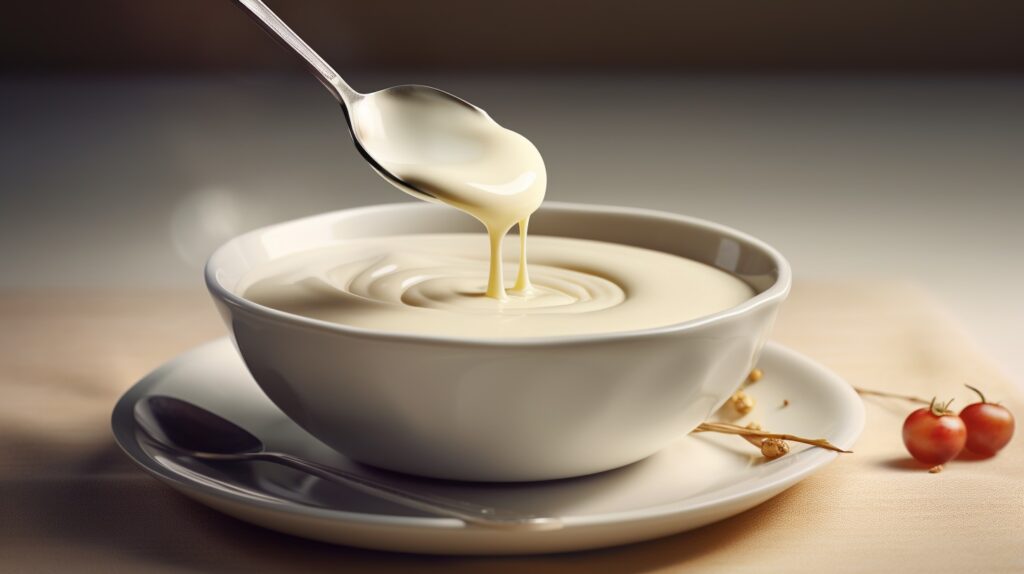In the realm of French culinary arts, roux and béchamel hold a prominent position. Both are key components in numerous iconic dishes, adding depth of flavor, richness, and texture.
While they may seem similar, especially to those new to cooking, their applications and composition are distinctly different. This article delves into the fascinating world of roux and béchamel, exploring their unique characteristics and how they contribute to the overall culinary experience.
Main Differences
Roux and béchamel serve different purposes in the kitchen. A roux is a mixture of fat (usually butter) and flour, cooked together to form the base of many sauces, soups, and stews. It acts as a thickening agent, with its cooking duration affecting the flavor and color of the final dish.
Béchamel, on the other hand, is a type of white sauce, one of the five “mother sauces” in French cuisine. It starts with a roux to which milk is added, resulting in a creamy, versatile sauce often used in dishes like lasagna, macaroni and cheese, and croque monsieur.
Flavor & Taste
The flavor of a roux depends on how long it’s cooked. A lighter roux (cooked for a shorter time) has a more subtle, buttery taste, while a darker roux (cooked longer) develops a nutty, toasty flavor. The roux’s taste influences the final flavor of the dish it’s incorporated into.
Béchamel sauce, being made from a roux and milk, has a creamy, mild flavor. It readily absorbs and complements other ingredients, making it a versatile base for many variations like cheese sauce (Mornay) or mustard sauce.
Nutrition Comparison
| Roux (per 100g) | Béchamel (per 100g) | |
|---|---|---|
| Calories | 406 | 110 |
| Protein | 4.3g | 3.3g |
| Fat | 36.5g | 7.4g |
| Carbohydrates | 18.7g | 9.1g |
Note: Nutritional values can vary based on the specific ingredients and proportions used.
25 Facts About Differences and Similarities

Fact 1: Origins
Both roux and béchamel have roots in French cuisine, showcasing the French emphasis on sauces and layered flavors.
Fact 2: Use in Other Cuisines
Roux is used globally, from Japanese curry to Creole and Cajun cuisine in Louisiana, while béchamel features prominently in Italian and Greek dishes like lasagna and moussaka.
Fact 3: Cooking Time
The cooking time for roux affects its color and flavor. For béchamel, the cooking time after adding milk to the roux impacts its thickness.
Fact 4: Mother Sauce
Béchamel is one of the five French “mother sauces” from which many other sauces are derived, while roux is a foundational technique used across these sauces.
Fact 5: Milk in Béchamel
The inclusion of milk is what primarily differentiates béchamel from a simple roux.
Fact 6: Roux Colors
Roux can be white, blonde, or dark, depending on how long it’s cooked.
Fact 7: Fat Types
Roux can be made with different types of fat, including butter, oil, or drippings from cooked meat, while béchamel traditionally uses butter.
Fact 8: Consistency
Roux is generally thicker, while béchamel has a pourable consistency.
Fact 9: Flavor Adaption
Béchamel can adopt various flavors through the addition of ingredients like cheese, herbs, or spices, while roux primarily influences the texture and base flavor of dishes.
Fact 10: Nutritional Values
Roux has higher fat and caloric content due to the equal parts of fat and flour, while béchamel, diluted with milk, is less calorific.
Fact 11: Gravy and Roux
Roux is often used as the base for gravies, giving them their thick consistency.
Fact 12: Roux in Stews
Roux can also be used in stews, like gumbo, to thicken and add flavor.
Fact 13: Béchamel in White Sauce-based Dishes
Béchamel is used in many white sauce-based dishes like creamed spinach or classic mac and cheese.
Fact 14: Cheese Addition
When cheese is added to béchamel, it becomes a Mornay sauce.
Fact 15: Roux in Soup
Roux is commonly used to thicken soups and enhance their richness.
Fact 16: Storage
Both roux and béchamel can be made ahead and stored in the refrigerator for a few days.
Fact 17: Roux Clumping
Adding cold liquid to a hot roux can prevent clumping when making sauces.
Fact 18: Flour in Roux
The flour in a roux must be cooked thoroughly to eliminate its raw taste.
Fact 19: Béchamel Seasoning
Béchamel is often seasoned with a touch of nutmeg in many traditional recipes.
Fact 20: Gluten-Free Roux
Gluten-free roux can be made using alternative flours, like rice flour.
Fact 21: Roux in Beurre Manié
A roux is similar to but cooked differently than a beurre manié, another thickening agent that’s made from equal parts flour and butter but isn’t cooked before being used.
Fact 22: Béchamel in Croque Monsieur
Béchamel is a key component in the classic French sandwich, croque monsieur.
Fact 23: Cooking Utensils
A whisk is a preferred utensil for combining the fat and flour when making a roux and when incorporating milk into the roux for béchamel.
Fact 24: Béchamel in French Onion Soup
A thick layer of béchamel is sometimes added to French onion soup before the cheese topping.
Fact 25: Roux in Cheese Soufflé
Roux is used in cheese soufflé to create the cheese sauce that’s then mixed with beaten egg whites (check what to cook with leftover egg yolk).
Related Articles & Recipes
- How to make Roux and Béchamel with Onion Cluté?
- Baked Chicken Breasts With Vegetables And Bechamel Sauce
Conclusion
Roux and béchamel, while originating from the same basic ingredients, diverge in their culinary applications and impacts on dishes. Understanding their differences and similarities allows for a deeper appreciation of food, its preparation, and ultimately its enjoyment. Whether it’s a rich roux-based gumbo or a creamy, béchamel-layered lasagna, these two culinary stars contribute significantly to making our meals deliciously memorable.
